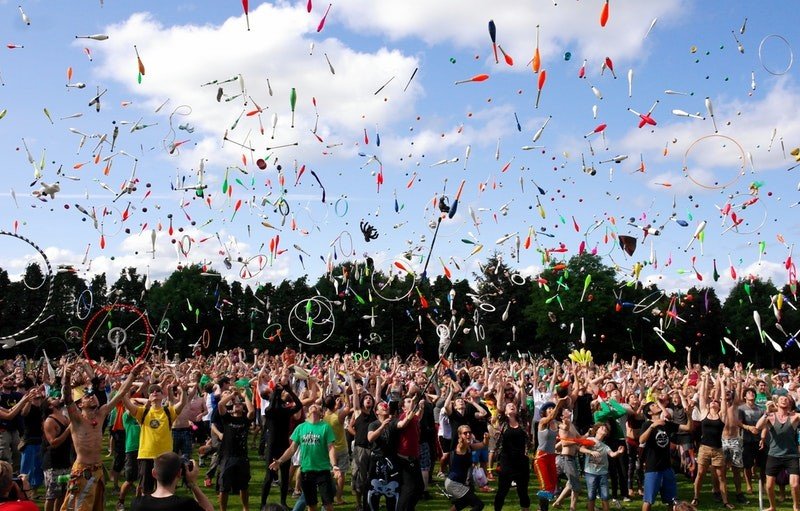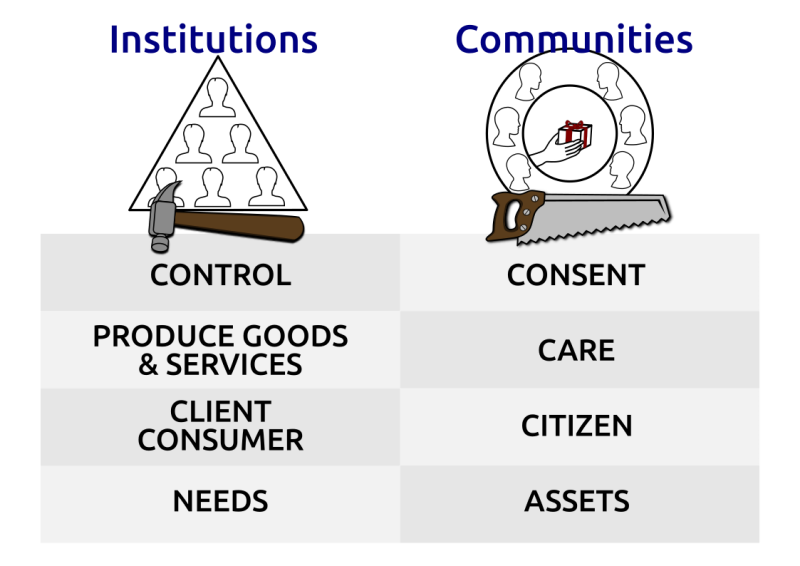
Touchstone Eight: Celebrate every step of the way
We’ve covered a lot of ground over the last two months in this series, entitled: The Eight Touchstones of Community Building.
We’ve also shared many ABCD stories from around the world. There are three important features of these Asset-Based Community Development examples:
- Capacity orientation
- Grass-roots Community Building
- Power building and power sharing.
1. Capacity Orientation- 3 Capacities Everyone has: Gifts, Skills, Passions
a) Gifts of the head, heart and hands, that we are born with, we do not have to earn, learn or have them given to us. They are our birthright. They are capacities that come naturally to us, when we engage in activities that exhibit our gift for music for example it feels relative effortless, like we’re in flow. Gifts are amplified and multiplied when individuals form effective associations. No matter how gifted you are at singing, you will never form a choir on your own.
b) Skills are capacities we practice and refine over time and with experience. While our gifts come naturally, that does not mean we are skilled in them, I might have a gift for running, but through practice and coaching, I can become more skilled. In the same way, just because I have a skill does not mean I am gifted at it. Most adults are reasonably skilled drivers, but not everyone can drive like a Formula One driver (most of whom are gifted drivers).
c) Passions are what we care deeply about and that we care about enough, to act on. Plenty of people care about living in a clean neighbourhood, but not all will join in on a community clean-up. We may not consider ourselves to be either gifted or skilled around many of the things we feel passionately about, but nevertheless we are prepared to show up and commit to make a contribution. The other feature of a passion is that it is not done out of a sense of duty, we are drawn towards the activity for which we have a passion and we are energized by it.
In ABCD community work we are particularly interested in what gifts, skills and passions people can bring to the wellbeing of the community.
2. Community Building Process: Discover, Connect, Mobilize
a) Discover: residents of a place work together to identify what they have. What they have includes their individual and group capacities; their environmental (natural & built), cultural, economy and institutional assets.
b) Connect: if we stop at the discovery phase all we will have is an inventory of local assets, such an inventory will help us have a conversation about possibilities, but it is not an action step. Hence to move the conversation forward we need to ask: ‘how can these assets that we have discovered be more productively connected to ensure a satisfying life for all of our neighbours?’
c) Mobilize: making connections between disconnected assets, for example the shared passions of five local residents for their local environment, is exciting, but until they show up and work together, to actually pick up the litter, nothing happens. Hence the third phase in ABCD (mobilizing) is about acting together in cooperation with other local assets (associational, cultural, environmental, economic), it is when we mobilize into action that we see and experience the transformative power of collective action. This process of learning by doing builds confidence, playfulness, trust and commitment.
3. Power Building & Power Sharing: Primary, Secondary, External Assets
Traditionally power is thought of as a zero-sum game. In a zero-sum game, there are those who have power and those who don’t, those that don’t must get it from those that do. This is only ever partially true. No one is totally powerless and no one is totally powerful. People may have their power disrupted, demeaned, overwhelmed or displaced, but not extinguished. That said people may feel very depleted in their personal and community power. When people feel this way, they often look to external agents to change the situation for them. This is understandable, but leaves them exposed to whims of the external agent. ABCD creates an alternative path to change, it helps us build power from inside out, so that when we do need to influence outside agents we can do so assertively and resourcefully. This internal orientation increases our capacity to identify, connect and mobilize assets that can:
- lead to a more satisfying life close to home
- build collaborative relationships
- influence those over whom you have no managerial power or leverage.
There are three levels of asset:
- Primary: assets which are local and within local control
- Secondary: assets which are local but outside local control
- External: assets which are neither local or in community control
By starting with a focus on primary assets, we can begin, almost immediately, to build up a sense of collective agency. As well as building a strong sense of morale among neighbours, working from inside out creates a powerful momentum for inclusion, since the more we search for primary assets the more we discover hidden local treasures, which we would never see if our focus was on external resources. Starting with a focus on what is strong and local calls on us to be willing to lift off labels that obscure people’s gifts. In this way, relational power is chosen in preference to positional power or privilege. The ABCD creed is: There is nobody whose gift is not needed, when it comes to building a powerful community, where everyone’s gift is given and received.
Relational power is infinite (abundant), positional power is finite (scarce). Hence ABCD helps communities build power and reveal abundance.
Comparing Institutions and Associations: 2 different tools for different jobs
These citizen-led efforts, were not stories about co-production of services between Institutions and Communities, they were stories about co-production of community wellbeing between citizens in neighbourhoods. Where institutions were involved, they were serving while walking backwards to create space and a halo of support, so to speak.

a) The Triangle: As illustrated above the function of an institution is to ensure quality control in the production of goods and services. It aspires to achieve this by establishing a structure (a triangle-with a CEO at the top for example) where the few control the many, hence guaranteeing standardized products, and satisfied clients/consumers. An effective institution’s primary orientation is addressing the needs of its consumers.
b) The Circle: Associations by contrast are effective only when they are made up of equals (hence the circle), in other words people who are joining together consensually to address something they care about. Their shared motivation is not the production of goods or services, but rather the restoration of the commons. Members of an authentic circle are not therefore, acting as employees bound by contract, or clients bound by need of service, but as citizens in a sort of covenant with each other. They are using their shared local assets as primary building blocks in co-producing a satisfying and inclusive life.
The Circle, is not better than the Triangle, they are simply different tools with different functions. You would not use a hammer to trim a tree. ABCD asks: “how can we use the right tools for social change, and where needed in proper sync with each other, so that we avoid getting bent out of shape?” One way of achieving this, is creating a new Social Covenant as distinct from a Social Contract.
Social Covenant
The essence of the ABCD Social Covenant is best expressed through the following three questions:
- What can we do ourselves?
- What can we do with a little bit of outside assistance?
- And what do we need somebody from the outside to do?
So, when we eventually get to the ‘external assets’ let’s plan to do so, as a powerful and assertive collective, with a clear statement of wants and offers, since that is how collaborative relationships are built, and where needed how oppressors are effectively challenged.
The Importance of Celebration
The relational grass-roots features described above are not the qualities we find in the majority of social change efforts, it is critical therefore that we celebrate them loudly and proudly, but also very clearly. Being clear about what we are celebrating and why, is of central importance in ensuring community driven change of this kind becomes more visible in the world.
One very practical way of celebrating citizenship is to make a habit (a practice) of having a ‘gift conversation’ at the end of every gathering. Just remember BIR: Behaviour, Impact, Results.
So the conversation goes like this:
Behaviour “When you…………”
Impact “It causes……….……”
Result “The result is……….”
“When you asked me what I’d like to contribute, it caused me to see that I am somebody and has resulted in my joining and contributing to the Open Village Initiative in a way I would not have done before. Thank you.” Now that’s worth celebrating at least as much as the actual event itself.
If we learn to celebrate the moments and relationship and not the monuments and events, we will see that there are endless opportunities to say thank you in an authentic way. It is through gift conversations that we give and receive support and that is what deepens community life. Committing in a covenantal way to celebrate the:
- capacities we discover,
- the processes we follow,
- the power we generate,
- and the irreplaceable functions we embrace
Is the means by which we transform a street of strangers, quietly waiting for external change, into a community of near neighbours, powerfully changing the World.
The Eight Touchstones are but some of the common avenues and lee-ways along which I have seen citizens around the world travel. I look forward to learning of many others, and remain hopeful that by sharing these eight, you become more emboldened and celebratory of the asset-based community driven efforts you and your neighbours are taking. Onwards!
Cormac Russell
Click here for the complete series: The Eight Touchstones of Community Building

Linda Viscardis
Hello Cormac! I want to share the Eight Touchstones but using the Search button does not yield any results. Would you be able to add links to the various articles at the bottom of this article? Pleeeeeease!? 🙂
Rashid Mhar
Very happy to do that Linda. We’ve created a link for the complete series here:
http://www.nurturedevelopment.org/tag/touchstones/
We will add this to each article in the series. Hope it helps.
Many thanks for bringing this to our attention.